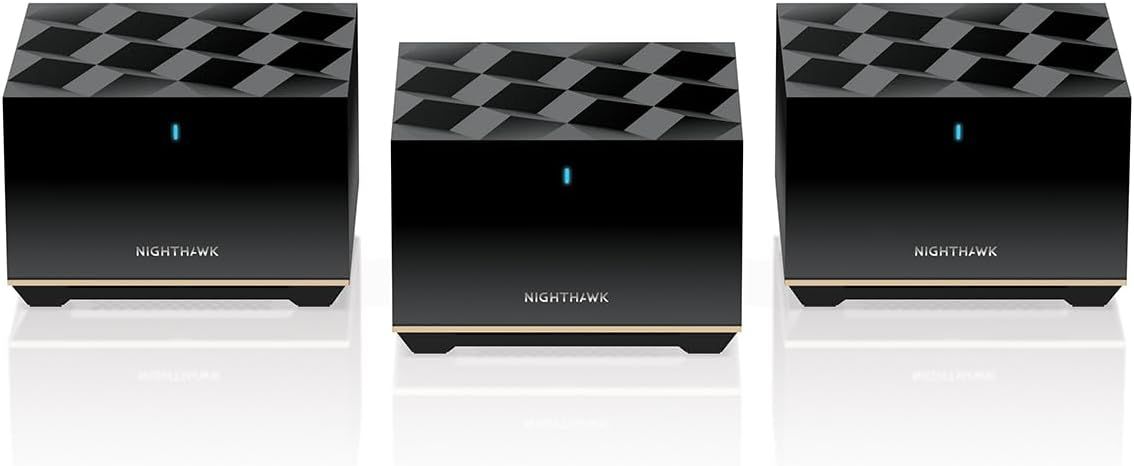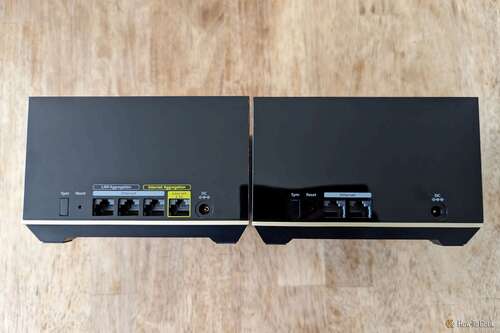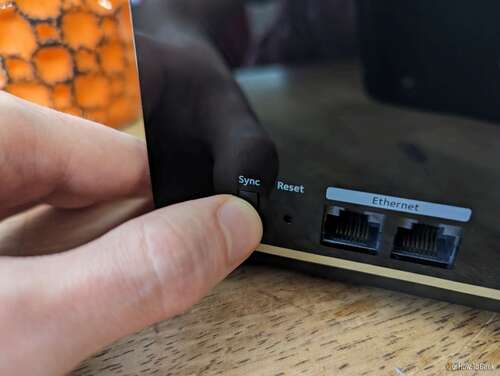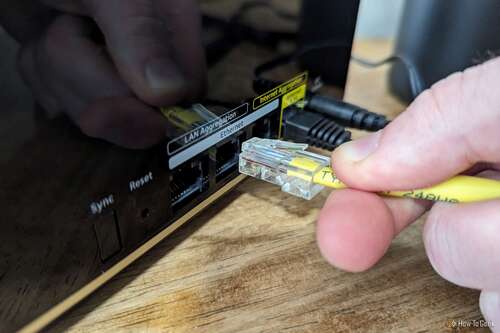Key Takeaways
- The Netgear Nighthawk MK93S Mesh Wifi 6E System offers fast Wi-Fi speeds up to 5.7Gbps for up to 100 devices and covers a range of up to 7,500 sq. ft. for whole-home coverage.
- The setup is easy and can be done through the Nighthawk mobile app or web interface.
- The system provides powerful controls for configuring and monitoring the network but lacks a toggle for the bright indicator light on the satellites.
Do you have a large property you want to blanket with fast Wi-Fi? You might be able to square that circle with the Netgear Nighthawk MK93S Mesh Wifi 6E System. It’s a set of three almost identical units, including a base router and two satellites, and the tri-band trio doesn’t skimp on coverage.


Netgear Nighthawk MK93S
$449.99 $549.99 Save $100
Engineered to deliver improved Wi-Fi performance, the Nighthawk tri-band mesh Wi-Fi 6E system keeps your home running with top Wi-Fi speeds up to 5.7 Gbps for up to 100 devices simultaneously and provides exceptional Wi-Fi range of up to 7,500 sq. ft. for whole-home coverage.
- Coverage
- 7,500 square feet
- Number of Devices Supported
- 100
- Bands
- 3
- Speed
- 5.7Gbps
- Wi-Fi Protocols
- Wi-Fi 6E
- Security
- WPA3-Personal
- Dimensions
- 5.51 x 5.51 x 3.62 in
- Ports
- 7 (3 x 2 x 2)
- Internals
- Quad-core 1.7GHz processor each
- Easy setup via multiple options
- Fast speeds across exceptional range
- Flexible controls
- No USB port
- No indicator light controls
Unlike some other mesh Wi-Fi systems, you can’t buy a base unit on its own or even a base unit and a single satellite. This three-pack instead can be augmented with additional satellites for expanded coverage. That could easily be overkill, though, as the steep $550 pricetag ($450 at the time of writing) gets you 7,500 square feet of wireless coverage that takes advantage of the 6Ghz band thanks to the still relatively new Wi-Fi 6E standard. While this powerful mesh system casts a wide net, you should make sure you actually need a net that big before buying.
Design: An Actual Black Box
Reminiscent of the ‘Star Wars’ mouse droids, these three Nighthawk access points are squat little boxes with a glossy, reflective finish and a cream accent stripe around the sides that you might notice sets it apart from the older Wi-Fi 6 generation. There are vents on the top and below, but the top-side vents struck me as a unique design choice because, when viewed from front angles create a sort of optical illusion. The vents become invisible and instead you see what looks like a repeating cube pattern.
In terms of overall looks, I guess I’m too hip to be square because I felt the egg look of my previous Google Wifi 6E mesh system blended into my decor better than the Nighthawk system. That’s just a preference, though, and the MK93S units are low-profile enough that few visitors would even likely notice them.
Not Every Port You Might Want
Ports on the main router (left) and one of the satellite nodes (right).
As far as ports go, with all the units put together, you get an impressive six ethernet ports, not including the central unit’s WAN port. Take a look and you might notice there’s no USB port on this router system. In comparison, the Nighthawk RAXE300 comes with a USB port while getting you Wi-Fi 6E speeds, as does the Linksys Hydra Pro mesh system. If you were hoping to flash these units with custom firmware or add network storage, that’s going to have to happen over ethernet.
Setup Is Easily Squared Away
I have set up a Nighthawk router before when reviewing the RAXE300, and with the Nighthawk mobile app (for Android or iPhone) it’s a straightforward process. If you don’t want to use the app, though, you can use a wired connection to your PC to set up via a web interface. That was pleasant to see is still true because some other modern router systems I’ve tried like the Google Nest Wifi Pro force you into the mobile app at set up and require access to location data.
Once the main router is connected, then you connect the satellites using a physical sync button. I saw some owners of the previous generation complaining the satellite sync was an exasperating process. It was virtually seamless for me, so if my experience is any indicator those issues were ironed out with this generation of the Nighthawk Tri-Band series.
Powerful Controls, Except in One Small Way
Once your connection is live, you have lots of options for configuring and monitoring the network. Most of the power is in the web interface rather than the app. Still, the mobile app alone had more capabilities than I was used to. You can test speeds, monitor network usage, get wireless analytics, and more. Opening the web interface will get you access to finetuning tools like channel management. This was a stark contrast to the standard router that my ISP Google Fiber provides which offers only the most basic of controls, some of which don’t even work.
One absence in the controls became glaringly obvious, though, when I put one of the satellites in my bedroom, and that was a light toggle. The blue indicator light is very bright and noticeable in a dark room. I prefer sleeping in complete darkness, so I tried in vain to find a setting to turn off or at least reduce the brightness. Google’s Nest Wifi Pro routers allowed me to do that, but I was stuck with the solid blue beacon in my room at night. Of course, if these weren’t review units I needed to return in good condition, I would have slapped a sticker over the light. Instead, I moved it to another room.
You Get the Performance You Pay For
Unsurprisingly based on the specs, this system was more than enough to meet my needs living on my own in a 1,400-square-foot house. In fact, the base router alone let me use the internet without issue throughout the home and outside on the back deck.
Netgear claims a “50% improved Wi-Fi performance than the previous model” with the MK93S. While I can’t test that myself, it doesn’t sound too far off, considering the Wi-Fi 6E protocol gets you access to the 6Ghz band. That alone can do wonders for network congestion. The catch is you can’t take full advantage of 6E’s improvements if you don’t have 6E-compatible devices, which are more common than they were a year ago, but still limited to mostly the latest products. The iPhone 15 and the 2023 MacBook line, for example, are the first Apple products to support Wi-Fi 6E. So you’re most likely to appreciate what the MK93S system’s capabilities if you buy the latest and greatest tech.
When testing with the Speedtest app on my 6E-compatible Google Pixel 6, I was easily able to achieve nearly the 1 gig upload speed I pay for when standing next to the router (with download speeds a little lower). Speeds dropped to close to half that when I stood next to a satellite, but even half a gig is far more than the speed any individual device needs to do its job. I noticed speeds were generally higher in the Netgear app’s built-in speed test compared to the Speedtest by Ookla mobile app’s results. I assume this is because the Netgear app can optimize the connection when it sees that as necessary.
To put the MK93S system to the test, I started up my current favorite PCVR game, “Blade & Sorcery,” and went one level down to my basement where I have space cleared for VR gaming. I connected my Meta Quest 2 headset to my PC using the Air Link feature so I could stream the game wirelessly to the headset. The connection hiccuped a little at first, but soon it seemed to work itself out I was able to play without noticeable lag. The game involves fast-paced combat where you’re making judgments and reactions second-to-second, so reducing latency is critical, and the MK93S was able to do that for me.
Price and Availability
The Netgear Nighthawk MK93S is available from Amazon and Best Buy for $449.99, or you can buy direct from Netgear for $549.99. If the standard coverage isn’t quite enough for you, you can pick up an additional satellite (MS90) that’ll run you $219.99 to add on 2,500 square feet of range.
Should You Buy the Netgear Nighthawk MK93S System?
If other routers let you down in terms of coverage, and especially if you like having fine control of how your network operates, the Nighthawk Tri-band Wifi Mesh Wifi 6E System is a solid choice. If you simply have an aging router, Wi-Fi 6E support is becoming standard in the latest tech (with Wi-Fi 7 only just now arriving on the bleeding edge), including popular gear like the Steam Deck OLED and the newest Apple products, so now is a great time to upgrade.
However, the MK93S is only available as a three-pack with a matching pricetag while other mesh solutions let you buy nodes individually. (You can add additional units, but you can’t start with less than three.) I enjoyed using the system, but it was far more than I needed in my humble-sized home, so I would prefer to start with one and build from there as needed. You’ll similarly want to make sure you aren’t overshooting in terms of the coverage. If you do want to cover a large area with a future-proof network, though, you can’t go wrong with the MK93S.


Netgear Nighthawk MK93S
$449.99 $549.99 Save $100
Engineered to deliver improved Wi-Fi performance, the Nighthawk tri-band mesh Wi-Fi 6E system keeps your home running with top Wi-Fi speeds up to 5.7 Gbps for up to 100 devices simultaneously and provides exceptional Wi-Fi range of up to 7,500 sq. ft. for whole-home coverage.




